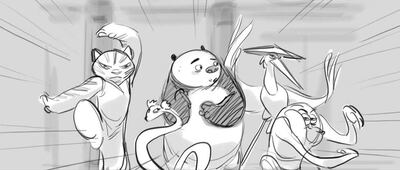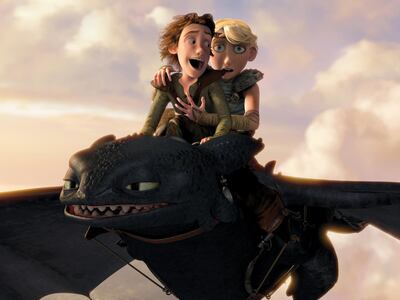Dreamworks Animation's head of story, Tron Mai, is in Dubai to give a talk at the –ing Creatives Festival, which takes place in Dubai Design District from tomorrow until Friday.
Mai, who has spent time as a storyboard artist or story development artist at studios including Disney, Sony, and Nickelodeon, has worked on some of the best-loved characters in recent animation, from the Rug Rats to Shrek, and Kung Fu Panda to Disney's Rapunzel. With a name like Tron – which he shares with 1982's groundbreaking Disney live action/computer animated movie – I suggest to Mai that perhaps he knew he would end up in his current role.
“It’s not actually my real name,” Mai says with a laugh. “But it’s not a total geek thing. When I was growing up at school in the US, none of the kids could pronounce my full name – Truongson – so I needed something shorter they could handle. Tron it was. Although I suppose as it turned out, it was quite an appropriate choice of name.”
Mai's name may be exactly the right one for his career path, but his choice of degree subject is perhaps surprising for someone who has become such a central figure in Hollywood's animation industry. Mai attended the Ringling School of Art and Design in Florida, but he didn't study on the college's animation course, choosing instead to study for a bachelor's in illustration. It's not a million miles from animation, but I ask Mai why he didn't specialise if he already knew that he was headed into the world of animation. "The advice I took was that if you study illustration, you can still get a job at one of the major animation studios, but you have all those other skills, too, rather than restricting yourself to animation. My main practical work has been with storyboards rather than the specific animation, and that's a skill that very much requires the illustration knowledge. The advice seems to have worked for me so far."

Mai has worked with some of the biggest names in the industry. Actors who have voiced his characters include Eddie Murphy, Cameron Diaz, Jack Black, Dustin Hoffman and Angelina Jolie, while his Dreamworks boss is founder Steven Spielberg, but for Mai, it seems to be the characters he's created that are his greatest delight: "It's a great job to have, and I get to work with some incredibly talented, great people, but you know, the biggest honour is to work with some of these characters that are so loved. To give those characters life and expression, and to be trusted to take those characters and tell their stories to audiences across the globe. That's a real honour."
There's a real fondness in Mai's voice when he talks about his work. Having been instrumental in creating some of the most enduring favourites of animated kids' cinema of the last couple of decades, I wonder if Mai has his favourite: "It's a tough question as I love so many of my characters," he says. "But if I had to choose just one it would have to be Toothless [the lead dragon from How to Train Your Dragon]. There's so much of that character that is based totally on my own dog, and I can see so much of him in Toothless when I watch the movie. His mannerisms, his expressions, the way he reacts in certain situations, all taken directly from my dog at home, so there's a really close link there for me."

Having come into animation as a professional in the late 1990s, just as digital animation was becoming a viable alternative to the more traditional drawn and 3D-model varieties, Mai says that technology had moved on apace, even during the course of his own, still relatively youthful, career. Perhaps surprisingly, Mai says that despite the arrival of super-powerful computers and programmes to help animators, the job hasn't got any easier. "Back when you used to have to draw each picture, you'd maybe make five or six photos for a quick section. Now, because we can go into so much detail and expectations are so high, you could maybe create 50 or 60 pictures for the same fraction-of-a-second's animation. The new technology has, ironically, maybe even made the process slower, but the results are worth it," he says.
The artist says that with technology advancing so quickly, and art forms such as virtual reality beginning to take an increasingly important place in the entertainment world, even he can't be sure where the animation game will be in 10 years, but he's excited about what the future may bring. "Things are just advancing so fast, it's impossible to say where the technology may go, but I do know it's a great time to be in animation," he says. "And I know that wherever the technology goes, what will always be the most important thing is the story. You can give me all the technology in the world, but without a great story that audiences can really get involved with, the technology is worthless."
Appropriately enough, when Mai stops off at the –ing Creatives Festival this weekend, he’ll be giving a talk on the story process in animation, and how it relates to artistic success.
More information is available from ingcreatives.com
__________________
Read more:
Studio Ghibli co-founder, director Isao Takahata dies at 82
Cosplay at Comic Con Dubai - in pictures
__________________





